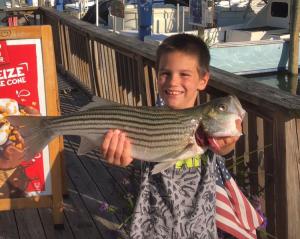There is no doubt that summer flounder are not as common as they once were, and that is because they have not had a large class for the past seven or eight years. Global warming has also played a part by making local waters warmer than they have been for more years than anyone can remember. Flounder have an upper avoidance water temperature of 72 degrees and an optimum water temperature of 62 to 65 degrees. This explains why Indian River and Rehoboth bays have had very poor flounder fishing during the summer, since the water temperature in both locations is well above 72 degrees.
The result of these two factors is the flounder have moved to deeper water where they can find more suitable temperatures. Locations like Reef Site 11 and the Old Grounds have been producing what few flounder we have, and both of those areas are just beginning to come on. Even now, limits are rare, and if you manage one or two keepers per trip, you have had a good day.
With flounder taking up station over reef sites or rough bottom, the old way of fishing by dragging a top-bottom rig baited with squid and minnows has not been as productive as jigging. Please do not tell me about your great success doing just that last week. Even a blind pig can find the occasional acorn, but for consistent action, jigs have been far more productive than top-bottom rigs.
So far this year, I have only been able to fish in the Lewes-Rehoboth Canal, and my success has been with a bucktail and Gulp! rig jigged across the bottom. I have only caught two keepers on one trip and several shorts on other excursions. That rig has completely out-fished all others used by my fishing companions.
If you get a chance, look at the setups used by successful charter boats or by anglers who catch flounder from head boats. I believe you will find more jigs than top-bottom rigs.
When fishing in the canal or other shallow-water locations, I use a single bucktail with a bright-colored Gulp! shrimp or crawfish. That is exactly what I caught my 5-pound flounder on. The same rig has also produced short flounder and one rockfish from the canal.
When I finally get a chance to fish in the ocean, I will be using a jig with a teaser set about 6 inches above the bucktail. Tsunami makes a rig that is perfect for this purpose. Called the Jigging Rig, it has a snap on the bottom with a small-skirted jig about 6 inches above. Just snap on a bucktail of the proper weight to carry the rig to the bottom and decorate both jigs with Gulp!, a strip bait cut from bunker or sea robin, or the old standby, squid.
One of my personal favorites is a Delaware Bay Green Machine baited with a minnow, Gulp! or strip bait and instead of a regular sinker, put on a Tsunami Ball Jig. This rig is not recommended for fishing over wrecks or reefs, but it works wonders over open bottom at the Old Grounds.
The key to successful jigging is jigging. You must keep the jig dancing just above the bottom by constantly working the rod up and down. Putting the rod in a holder and opening up a cold drink is not going to produce nearly as well as keeping the rod in hand to keep the jig moving.
I prefer using a conventional reel with a matching rod. Fill the reel with 20- or 30-pound braid, then put a shock leader of 30-pound Fluorocarbon on using an Albright or slim beauty knot. Fluorocarbon has a much higher abrasion resistance than braid, and since you will be jigging over rough bottom, it pays to use the shock leader.
Folks who fish from head boats should use a bit heavier tackle. You don’t want to be constantly in a tangle with other anglers, so it’s important to use tackle that can accommodate a big dog shark or ray. I use a Tsunami HYBRID 28 reel and 40-pound braid on a rod that will handle eight ounces if necessary. I stick with the 40-pound Fluorocarbon shock leader.
Fishing report
More flounder and sea bass have been caught at the Old Grounds, Site 11 and the Del-Jersey-Land Reef than in previous weeks. The offshore canyons produce tuna, marlin and dolphin, but you have to use temperature charts to find the warm-water eddies before you leave the dock. Delaware Bay has seen croaker, kings, blues and trout at the reef sites. A few flounder are also in the mix.























































